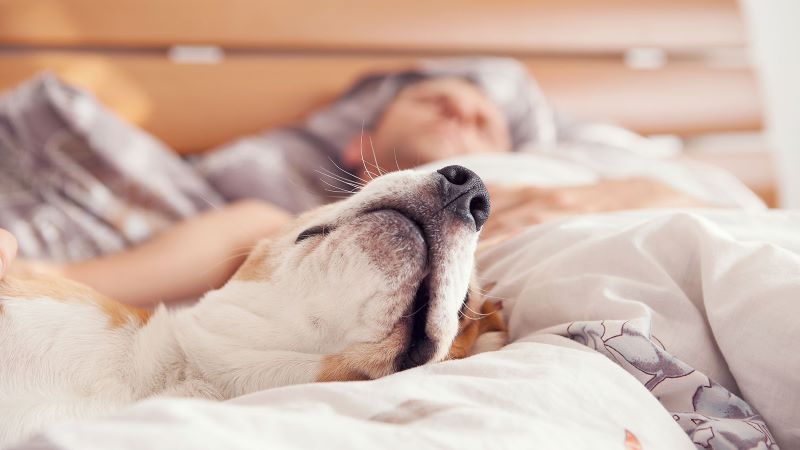Roughly 85 million families own a pet in the United States according to the 2019-2020 National Pet Owners Survey conducted by the American Pet Products Association (APPA). Another survey by the same association found that almost 60 percent of dog owners regard their pet as a member of the family. A significant number of those pet owners also allow their pets to sleep in the same bed as them!
Pros of co-sleeping with a pet
Safety
For those living along, sleeping with their pet can feel like a type of security blanket. If you own a pet and hear a strange noise in the night, odds are good that you look to your pet to see what their reaction is to the noise. Even a domesticated animal will still retain survivial instincts from its ancestor that can keep them safe from danger. Unfortunately, if your pet is very reactive, you may be woken up through the night for every little sound from cars passing to shadows on your wall.
Relaxation and bonding
Sleeping with your pet can allow for your bond to strengthen. Animals are used to sleeping closely with their pack, and you allowing them into the bed means they feel even closer to you emotionally. It's been proven that the act of petting and being near to cats and dogs releases hormones that lead to feelings of comfort and relaxation. Sleeping with your pets may help your body to calm down at night so you can rest easier.
Cons of sleeping with your pet
Allergies
If you're at all allergic to animal dander, sleeping with your pet may not be the best for you! Allowing your pet into the bed means also inviting in all their hair and dander. Your sheets are likely to trap this hair and set your allergies off every time you try to fall asleep. Choosing to wash you bedsheets and clean your headboard frequently may be a way to alleviate some of the allergens if you won't let your allergies get in the way of a good snuggle.
Less sleep
If you're a light sleeper, your pet moving in the night may cause you to spend more time awake than asleep. Pets also go through sleep cycles, however theirs is a little different than ours. In fact, while humans average about four or five complete sleep cycles in a typical night, a dog will have shorter 15-minute cycles and often experience close to 20 per night. If your pet dreams and often twitches or "runs" in their sleep, you may be woken up when flailing paws connect with your body.
Illness and disease
If you keep your pet up to date on their vaccinations and visit your vet every year for preventative care visits, you shouldn't need to worry about getting an illness from your pet. Pets do often bring dirt and additional germs into your bed, so changing your sheets often is important if you choose to co-sleep.
Make co-sleeping a priority
If you can't dream of a night without your pet snuggled close in your bed, there are a few things you can do to keep everyone happy.
1. Be sure that everyone in your family agrees that pets should be allowed on the bed. It can be confusing to a pet if some members of the family allow bed snuggles but other angrily remove them from the bed.
2. Establish boundaries. If you want your pet to sleep on your pillow that's fine, but if you'd prefer they stay at the foot of the bed don't allow them on the pillow one night only to correct them later on.
3. Regularly treat your pet for fleas and ticks and keep him up to date on all vaccinations.
No matter what you choose, everyone (including your pet) should get the rest they need.

